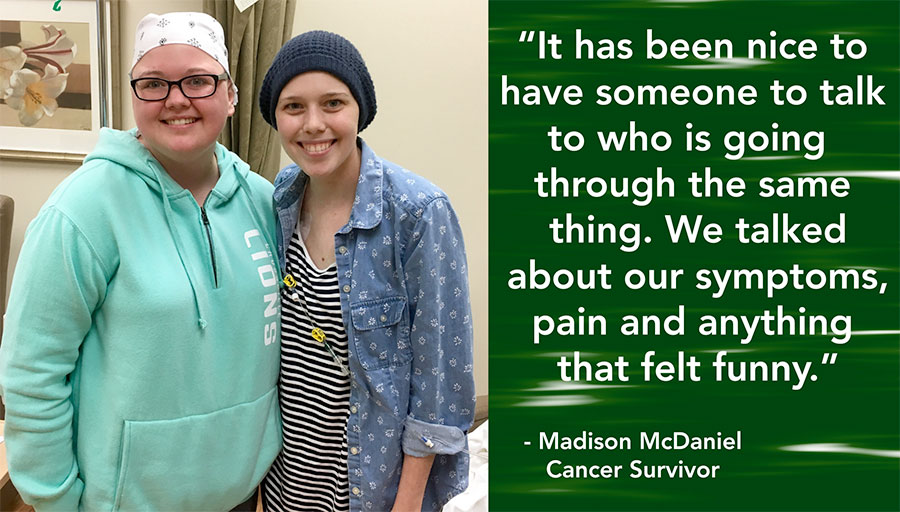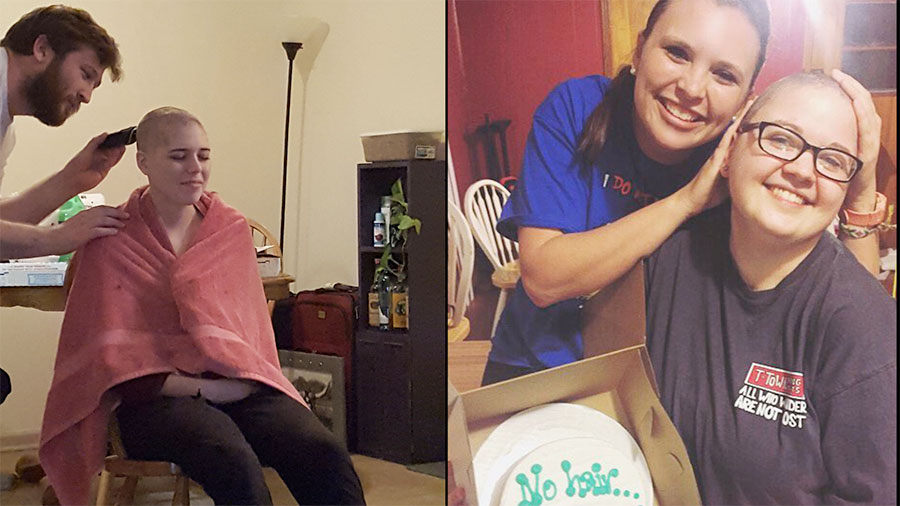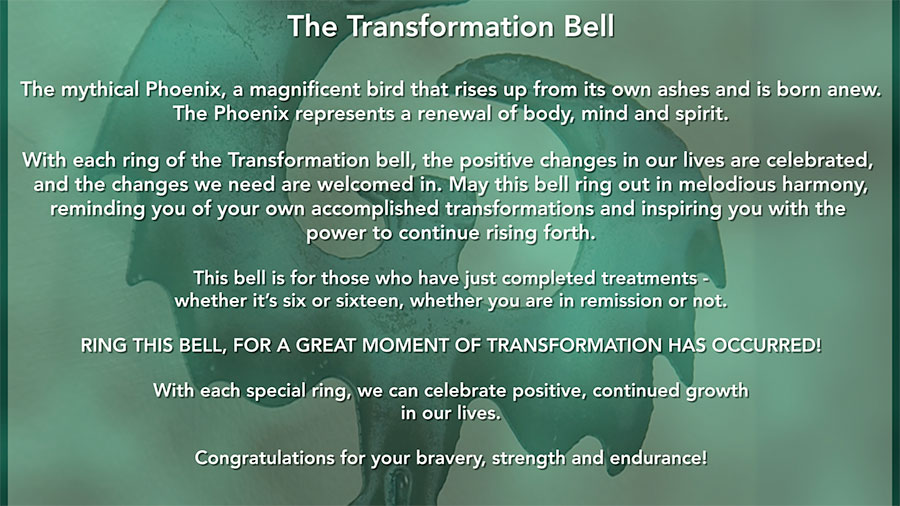Morgan Ellison and Madison McDaniel were diagnosed with a rare germ cell tumor of the ovary earlier this year. The two strangers would soon form a unique bond during their treatment in Birmingham, Alabama.
Madison began having stomach pain Christmas Day, sending her to the emergency room for what she thought were kidney stones. A mass on her ovary the size of a grapefruit was discovered. In January, her physician in Boaz, Alabama, removed the mass and part of her left ovary to determine whether it was cancerous.
Physicians referred Madison to J. Michael Straughn Jr., M.D., a gynecologic oncologist at the University of Alabama at Birmingham. Straughn diagnosed her with a rare but curable germ cell cancer, and then removed the remainder of her left ovary Jan. 25. The toughest part of her journey began Monday, Feb. 8, when Madison started a rigorous nine-week treatment of chemotherapy.
“From day one, Madison had a positive attitude and really held the family together,” said Alicia McDaniel, Madison’s mom. “She was very sick from the chemo from the beginning. I knew it was going to be a tough nine weeks.”
As Madison was receiving the life-altering news, Morgan was visiting family in Waco, Texas, in early January when she collapsed while packing her car to go home to Tuscaloosa, Alabama. She previously had trouble with a pinched nerve and pain in her foot, so she did not think much of it. She visited an urgent care clinic to be checked out.
When she returned to Alabama, she had several doctor’s appointments to evaluate what was going on with her pinched nerve and determine the appropriate treatment. During an MRI, the doctor caught a glimpse of her ovary, which was enlarged. She was sent to her gynecologist for more tests, who immediately referred her to Rebecca Arend, M.D., a gynecologic oncologist at UAB Hospital.
“It was all moving so fast that there was barely time to think,” said Debbie Rivera, Morgan’s mom. “I was scared to death. We went from diagnosis to surgery in seven days. I went in so blindly, not knowing how tough this was going to be for Morgan.”
Morgan learned she had the type of germ cell cancer found only in young women in their teens and early 20s. Arend removed Morgan’s right ovary Jan. 19, starting chemotherapy two weeks later.
“The paramount thing was the two of them having each other during treatment of a rare disease,” Arend stated. “Patients are often going through something like this alone, so having a friend the same age is unique.”
Support beyond a group
 Both women were prescribed the same treatment plan: three cycles of chemotherapy, a rigorous nine weeks of consisting of three drugs that tend to be tough for most patients. The first week of each cycle is a five-hour treatment given daily for five days. The second and third week of each cycle is a one- to two-hour treatment one day a week.
Both women were prescribed the same treatment plan: three cycles of chemotherapy, a rigorous nine weeks of consisting of three drugs that tend to be tough for most patients. The first week of each cycle is a five-hour treatment given daily for five days. The second and third week of each cycle is a one- to two-hour treatment one day a week.
“I was in my second week of treatment when Madison walked in for her very first round of chemo,” Morgan said. “When you receive the chemo, you give your name and date of birth. That’s when I realized Madison was just a year younger than me. It looked like she was getting the same type of treatment as me, which really caught my attention since my cancer was so rare.”
“I remember seeing Madison that day too,” Debbie said. “She started asking the nurse the same questions Morgan had during her first treatment. We had already been through that first week of treatment, which was extremely hard for Morgan. I remember thinking, ‘oh, honey, it’s going to get so much harder than that.’”
Once Madison discovered there was another young woman diagnosed with her same cancer, the two became friends and an important part of each other’s support system, getting through treatment together.
Each understood what the other was going through. Discussing symptoms with their nurses and families was one thing, but to have another person going through the same diagnosis made it OK to feel the pain and to be scared, while offering a sense of comfort too.
“Everything was so similar. It’s crazy,” Madison said. “During our chemotherapy, we talked a lot. It has been nice to have someone to talk to who is going through the same thing. We talked about our symptoms, pain and anything that felt funny.”
“Of the 22,000 cases of ovarian cancer diagnosed each year, 5 percent will be a germ cell tumor,” Straughn said. “Morgan and Madison took on the journey of their treatment together. It decreased their anxiety, making the rareness of the tumor seem less scary.”
Texting back and forth became a daily occurrence. When one was sick, the other could sympathize with how she felt and give advice on what might make it better.
“I can always tell when Morgan and Madison received their treatment together,” Debbie said. “They are both quiet girls, but they would have a more positive outlook when they left treatment together.”
“They were constantly putting on a strong front for the families, but this came down when they were with each other. It was as if they were giving each other strength in a different way. To feel it, to say you feel it is one thing; but to have someone understand it is another.”
The families began to support each other as well. Debbie and Madison’s grandmother, Janice Kidd, would sit in the waiting room during chemotherapy comparing notes, asking questions and enjoying each other’s company. It made it easier to deal with the physical changes each family was experiencing in Madison and Morgan, as well as the looming cancer.
A sad moment celebrated
 Morgan, left, and Madison enjoy "no hair, don't care" celebrations with friends, pizza and cake.Toward the end of the first cycle of treatment, Morgan began losing her hair. Her mom found the perfect way to turn a sad moment into something to help her get through losing a piece of her physical attributes. She had always had long, full hair and had cut it off to her shoulders after finding out about her cancer.
Morgan, left, and Madison enjoy "no hair, don't care" celebrations with friends, pizza and cake.Toward the end of the first cycle of treatment, Morgan began losing her hair. Her mom found the perfect way to turn a sad moment into something to help her get through losing a piece of her physical attributes. She had always had long, full hair and had cut it off to her shoulders after finding out about her cancer.
Morgan’s hair began falling out, but her best friend from Texas was coming into town in just a few days. Morgan held out for her to get to Alabama. As they left the airport, the two girls headed straight to the drug store to get an electric razor. Debbie ordered pizza and had a cake waiting at home.
Morgan’s friends in Tuscaloosa hurried over for what was now set to be a celebration of how far she had come and the ultimate girls’ night. One at a time, the friends shaved Morgan’s head, making a joyous celebration of her battle with cancer.
The next week, Madison mentioned to Morgan that she was starting to lose her hair now. She was unsure what to do. Morgan gave her advice on having a special party with close friends to ease the embarrassment. They were texting ideas and photos leading up to Madison’s big party.
“I thought it was going to be really sad,” Madison said. “It was just me and my best friends. We watched movies, ate pizza and celebrated with cake. Just like Morgan, my friends took turns helping me shave my head. It was nice. I was glad to have my close friends there, instead of being by myself.”
A setback was worth it
During the first two cycles, Morgan and Madison would see each other during chemotherapy, but not always be on the same schedule. On the day Morgan began her second cycle, which was her long week consisting of five days of treatment for five hours at a time, she learned — when texting with her friend — that Madison was in the hospital.
“Morgan asked if she could see her to offer some encouragement,” Arend recalled.
Morgan put on a mask and headed straight for Madison’s room. The two talked through their symptoms, comforted each other and confided in one another.
On March 7, Morgan’s treatment was delayed one week due to neutropenia, an abnormally low white blood cell count, and the two young women ended up on the same chemotherapy schedule for the last three weeks of their treatment.
That is when their unbreakable bond formed.
The final bell
 For three weeks, they spent their time hanging out during chemotherapy, where they would catch up on what was going on in each other’s lives in between catnaps. When they were not together, they stayed in touch.
For three weeks, they spent their time hanging out during chemotherapy, where they would catch up on what was going on in each other’s lives in between catnaps. When they were not together, they stayed in touch.
Monday, April 18, had finally arrived, the final day of chemotherapy.
Morgan and Madison sat in their chairs together as their families and friends gathered. Therapy is always a waiting game. Fluids are administered; it takes time to get everything ready.
“I’ve met a lot of strong women while in treatment, and it’s not their first time to go through chemo,” Morgan said. “I think Madison had a harder time with treatments. She is so strong. I really admire her for that.”
Madison’s final drugs were administered first. It was dead silent as the two families waited and watched. As the nurse finished, Madison burst into tears of happiness, her mom running over to hug her.
Morgan, seated right next to her, celebrated with her, waiting for her turn. As the nurse prepped her for her final treatment, tears of joy streamed from everyone’s faces.
Morgan’s treatment was completed, and her family joined in on the celebration.
“Morgan played a big role in supporting me through this,” Madison said. “She helped me stay positive, making it easier. Now it’s over. I always reminded myself that it could be worse.”
It is customary for cancer patients to ring “The Transformation Bell” once their chemotherapy is complete. Debbie and Alicia grabbed the bell and held it up for the two girls. The two families gathered around.
Madison and Morgan looked at each other with relief, as if a weight had been lifted. With tears in their eyes, they rang the bell signaling the end of their trying journey, surrounded by two families celebrating their triumph over a rare cancer together.